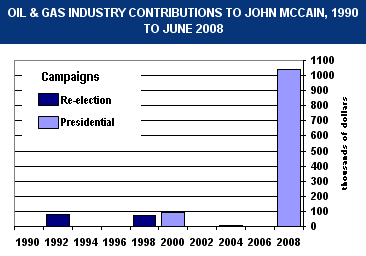John McCain’s new coziness with Big Oil is in many respects just a replay of his old coziness with Charles Keating. In both cases, money and access bought influence. Let’s start with oil.
Last month, Time reported that McCain tapped a “prominent Washington lobbyist,” William E. Timmons, Sr., to run his transition, should he win the election. Who does Timmons and Company lobby for? As of this year, they are getting about $100,000 a quarter from the American Petroleum Institute (API).
More than 20 top McCain advisers and fundraisers have lobbied for Big Oil, including Charlie Black, Senior Political Adviser (whose clients include Occidental, Yukos Oil, Chinese National Off-Shore Oil Corp.) and Wayne Berman, National Finance Co-Chairman (Hess, Chevron, Texaco, API).
What does the access get Big Oil? Let’s see. McCain has almost completely walked away from the climate issue. He picked Big Oil’s dream VP, Alaska Governor Sarah Palin. And, of course, back in July, as the Washington Post headline blared, “Industry Gushed Money After Reversal on Drilling“:
Oil and gas industry executives and employees donated $1.1 million to McCain last month — three-quarters of which came after his June 16 speech calling for an end to the ban — compared with $116,000 in March, $283,000 in April and $208,000 in May.
That is a lot of quid for a lot of quo, a lot of cash for trashing his image as an environmentalist or as a reforming maverick. Of course, we’ve seen that the environmental image was always fictional.
Yet, the image of McCain as someone who fights against lobbyists, rather than cozies up to them, is also fictional, as the sordid story of the Keating Five (excerpted below) makes clear. The past is indeed prologue:
Keating was the chair of Lincoln Savings and Loan Association of Irvine, California, and he “ultimately served five years in prison for his corrupt mismanagement of Lincoln.” Lincoln had become “burdened with bad debt resulting from its past aggressiveness, and by early 1986, its investment practices were being investigated and audited” by the Federal Home Loan Bank Board over whether it had violated rules limiting certain kinds of risky, direct investments. [Hmm. That certainly sounds familiar.] “Lincoln had directed FDIC-insured accounts into commercial real estate ventures. By the end of 1986, the FHLBB had found that Lincoln had $135 million in unreported losses and had surpassed the regulated direct investments limit by $600 million.”
The core allegation of the Keating Five affair is that Keating had made contributions of about $1.3 million to various U.S. Senators, and he called on those Senators to help him resist regulators. The regulators backed off, to later disastrous consequences.
In 1991, the Senate Ethics Committee found that McCain had exercised “poor judgment” for meeting with federal regulators on Keating’s behalf. Other members of the Keating Five were found to have acted improperly. Many independent observers thought all five got off lightly, especially McCain, who had far closer ties to Keating than the others:
Fred Wertheimer, president of Common Cause, which had initially demanded the investigation, thought the treatment of the senators far too lenient, and said, “The U.S. Senate remains on the auction block to the Charles Keatings of the world.” Joan Claybrook, president of Public Citizen, called it a “whitewash.” Jonathan Alter of Newsweek said it was a classic case of the government trying to investigate itself, labelling the Senate Ethics Committee “shameless” for having “let four of the infamous Keating Five off with a wrist tap.” Margaret Carlson of Time suspected the committee had timed its first report to coincide with the run-up to the Gulf War, minimizing its news impact. One of the San Francisco bank regulators felt that McCain had gotten off too lightly, saying that Keating’s business involvement with Cindy McCain was an obvious conflict of interest.
McCain’s incredibly close ties with Keating foreshadow his incredibly close ties with lobbyists today, especially with the oil industry. Consider just how cozy Keating was to McCain:
McCain was the closest socially to Keating of the five senators … Between 1982 and 1987, McCain had received $112,000 in political contributions from Keating and his associates. In addition, McCain’s wife Cindy McCain and her father Jim Hensley had invested $359,100 in a Keating shopping center in April 1986, a year before McCain met with the regulators. McCain, his family, and their baby-sitter had made nine trips at Keating’s expense, sometimes aboard Keating’s jet. Three of the trips were made during vacations to Keating’s opulent Bahamas retreat at Cat Cay. McCain did not pay Keating (in the amount of $13,433) for some of the trips until years after they were taken, when he learned that Keating was in trouble over Lincoln.
So McCain’s unethical behavior today in his campaign, his cozy relationship with lobbyists and industry fat cats whose agenda he pushes, is nothing new.
It is time for everyone, including the media, to stop pushing the myth that McCain is now or has ever been a maverick or a reformer. As Rolling Stone puts it in the best article I’ve seen at connecting the dots of McCain’s entire life, he is nothing but a “Make-Believe Maverick.”
This post was created for ClimateProgress.org, a project of the Center for American Progress Action Fund.



